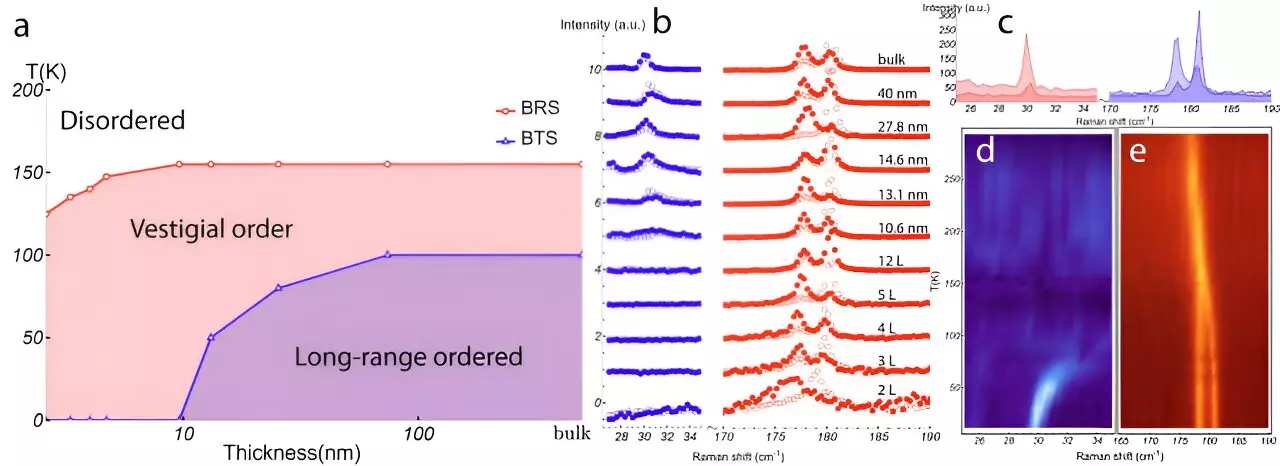The intricate world of nanomaterials is increasingly gaining the attention of the scientific community, particularly in the field of magnetism. Recently, a collaborative study conducted by physicists from The University of Hong Kong (HKU), Texas Tech University (TTU), and the University of Michigan (UMich) revealed groundbreaking insights into van der Waals (vdW) magnetic materials. Their research concentrated specifically on nickel phosphorus trisulfide (NiPS3), which has begun to highlight the fascinating interplay between dimensionality and magnetic properties at the nanoscale.
Van der Waals materials are characterized by their unique two-dimensional (2D) structures, where the atomic layers are bound together by weak forces. This allows for easy manipulation of their thickness, leading to a wealth of possibilities for customization and exploration. The study of NiPS3 is pivotal as it transitions from a three-dimensional state, characterized by long-range magnetic order, to a reduced two-dimensional vestigial order state as its thickness decreases. Understanding these transitions is not merely an academic exercise; it lays the groundwork for innovative applications in electronics and energy storage.
The research published in *Nature Physics* sheds light on how these materials can potentially revolutionize technology. The shift from a conventional magnetic order to a vestigial state as NiPS3 is thinned exemplifies how tiny variations in structure can lead to dramatic changes in functionality, thereby paving the way for more efficient electronic devices, energy storage solutions, and next-generation computing platforms.
At the heart of the exploration of NiPS3 lies the theoretical principles of symmetry breaking—a core concept in condensed matter physics. When transitioning between magnetic states, materials may undergo symmetry changes, resulting in different physical properties. The concept of vestigial order signifies a more nuanced view, where certain symmetries are preserved even as others break down. This phenomenon challenges traditional notions of phase transitions, offering a new lens through which to examine material behaviors at nanoscale thicknesses.
This research not only marks a significant milestone as the first experimental demonstration of such a transition in NiPS3 but also provides evidence of vestigial order via sophisticated techniques like nitrogen-vacancy spin relaxometry and optical Raman quasi-elastic scattering. These methods enabled the researchers to visualize how magnetic order diminishes and reconfigures as the material is reduced to a few layers or even a single layer.
Monte Carlo Simulations: Bridging Theory and Experiment
To complement their experimental findings, the research team employed large-scale Monte Carlo simulations, enhancing the understanding of the physical interactions at play within bilayer NiPS3. These simulations revealed the nuanced behavior of magnetic phases and further corroborated their experimental observations, showcasing the transition from primary order to vestigial order. By tracking these changes, the authors not only analyze the nature of the phase transition but also provide a pivotal link in understanding the differences in behavior between 2D and 3D systems.
Such comprehensive research offers new insights into what Feynman proposed back in 1959 regarding the ramifications of manipulating materials at the atomic level. With the experimental realization of vestigial order and the development of computational frameworks, scientists are now equipped to explore Feynman’s inquiry on layered structures with newfound vigor.
The potential applications of these findings could be revolutionary. Layered materials like NiPS3 open avenues toward the development of various planar electronic devices, emphasizing performance while minimizing power consumption. With characteristics such as flexibility and transparency, these materials are well-positioned to influence the future of ultradense and low-power electronics. The ideal combination of properties could lead to advancements in 2D logic circuits and memory devices, representing a material revolution akin to the historical developments sparked by Feynman’s original thoughts.
The groundbreaking discovery regarding NiPS3 is not just an academic milestone but a significant step towards realizing the futuristic vision of nanotechnology. The convergence of experimental validation, theoretical understanding, and computational analysis in this study exemplifies how interdisciplinary efforts can lead to monumental advancements in science and technology. As researchers continue to peel back the layers of vdW materials, the pathway toward innovation is becoming increasingly illuminated, steering us closer to practical applications that were once confined to the realm of speculation.

